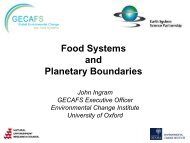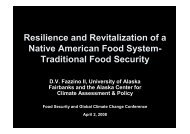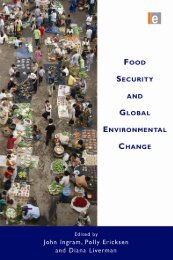In addition <strong>to</strong> broadening the debate from the relatively-narrow, biophysical research onimpacts of climate change on crop growth, the GECAFS food system concept was speciallydesigned <strong>to</strong> enhance interdisciplinary research on the two-way interactions between GEC andefforts <strong>to</strong> meet food security. Integrating the notions of food system activities with foodsecurity outcomes (Figure 1), the GECAFS food system concept provides a framework fordesigning research <strong>to</strong> systematically analyse a wide range of GEC-food security interactionsand questions. It has proven robust across a range of socioeconomic and geographicalcontexts, strengthened by the recognition of the range of ‘scales’ and ‘levels’ inherent inmodern food systems. ‘Scale’ is the spatial, temporal, quantitative, or analytical dimensionsused <strong>to</strong> measure and study any phenomenon, and ‘levels’ is the units of analysis that arelocated at different positions on a scale (Gibson et al., 2000; Cash et al., 2006). Apredominant feature of 21 st Century food systems is that they are inherently cross-level andcross-scale (Ericksen et al., 2010a).The following examples illustrate the utility of this food system concept for improvingunderstanding of vulnerability of food systems <strong>to</strong> GEC; analysing the consequences oftechnical interventions on food security outcomes; analysing the consequences of foodsystem activities for environmental parameters; framing scenario analyses; and analysing thefood security dimension in international environmental assessments.Example 1: Analysing the vulnerability of food systems <strong>to</strong> GEC and identifyingadaptation optionsThere is a rich and diverse food security literature addressing the vulnerability of individualsand/or households <strong>to</strong> a range of stresses including GEC (e.g. (Adger, 2006; Ericksen, 2008b;Misselhorn et al., 2010)). By considering the whole food system, it is possible <strong>to</strong> identifywhere vulnerability arises within the full range of food system activity ‘determinants’, i.e. thefac<strong>to</strong>rs that determine how a given food system activity in undertaken/operates (Eakin, 2010).Focussing on these, rather than the food security outcomes per se, helps indicate what, whereand how adaptation measures <strong>to</strong> enhance food security in the face of GEC might be mosteffective. Further, looking across all food system activities offers the chance of identifyingintervention points that might not be apparent if, for instance, one only considers theagricultural aspect. This is exemplified by a case study of the vulnerability of district-levelfood systems <strong>to</strong> GEC in the Indo-Gangetic Plain.Major investment in infrastructure has allowed Ludhiana District of the Indian Punjab <strong>to</strong>developed very effective irrigated agriculture, but excessive ground water extraction (alocally-significant environmental change) has significantly lowered water tables, therebyreducing irrigation supply. This will be exacerbated by anticipated changes in rain and glaciermelt, leading <strong>to</strong> a major vulnerability point relating <strong>to</strong> producing food. This, in turn threatensthe ‘producing food’ activity, affecting the overall food production at the District-level andhence the ‘availability’ component of food security (Figure 1). In contrast, in the Ruhani42
Basin District in Nepal’s Terai region, where food production has his<strong>to</strong>rically often sufferedfrom poor harvests, local food security depends on the ability <strong>to</strong> move food from village <strong>to</strong>village, especially in times of stress. <strong>Food</strong> distribution infrastructure is however not robust,and increased flooding due <strong>to</strong> GEC-induced potential glacier melt coupled with more extremeweather will disrupt footpaths, bridges and other vital aspects, affecting the ‘distributing’activity, and thence the distribution element of food availability (Figure 1). The food systemapproach identified the principle vulnerability points in the two Districts and shows them <strong>to</strong>be quite different. They will need very different adaptation responses <strong>to</strong> reduce theirrespective vulnerabilities. Improved water governance would reduce the food systemvulnerability in the Indian case (Aggarwal et al., 2004), while in the Nepali case, investmentin infrastructure and policies for strategic food reserves at local level are needed (Dixit,2003).Adaptation options <strong>to</strong> reduce food system vulnerability tend <strong>to</strong> focus on technicalinterventions <strong>to</strong> increase food production. By and large, and as noted above, these aretargeted at increasing yields of crops, lives<strong>to</strong>ck or fish, and are important in many parts of theworld, especially sub-Saharan Africa. These are complemented by advances in food s<strong>to</strong>rage,processing and packaging which have helped limit post-harvest losses and combat foodwaste. However, and as the Indian and Nepali cases show, options <strong>to</strong> adapt <strong>to</strong> the additionalstresses that GEC will bring also need <strong>to</strong> be vigorously explored in the policy domain. Thesemay be particularly effective when considered at regional level and over multiple years(Liverman and Ingram, 2010). Examples include establishing strategic grain reserves for aregion, harmonizing regional trade and quarantine agreements, introducing water pricing andagreeing the sharing of water and other natural resources (Aggarwal et al., 2004), (Drimie etal., 2011). Other options related <strong>to</strong> improving regional infrastructure, such as road, rail andharbour facilities allow the rapid movement of food in a crisis. These all need <strong>to</strong> beconsidered when seeking ways <strong>to</strong> reduce the vulnerability of the food system <strong>to</strong> GEC, and theGECAFS framework helps <strong>to</strong> remind researchers and decision-makers of the wide range ofpotentials interventions that need <strong>to</strong> be considered.Example 2: Analysing the consequences of interventions on food security outcomesExample 1 discusses the identification of food system ‘vulnerability points’ and considersadaptation interventions in different food system activities (producing food and distributingfood). When discussing adaptation interventions in response <strong>to</strong> GEC, it is important <strong>to</strong>explicitly state how a given intervention <strong>to</strong> a food system activity will affect the ‘target’ foodsecurity element. While adapting agronomic practice can have direct and clear impact onincreasing food production, the impacts of more novel technologies on other food securityoutcomes may be less obvious, especially when applied <strong>to</strong> other food system activities. Theseinclude information and telecommunications (ITC) technologies which are playing everincreasingroles in food systems. Although perhaps less relevant <strong>to</strong> developing worldsituations (at least at present) will likely constitute important <strong>to</strong>ols in the basket of adaptation43
- Page 1 and 2: From Food Production to Food Securi
- Page 3 and 4: From Food Production to Food Securi
- Page 5 and 6: Table of ContentsAbstract .........
- Page 7 and 8: Paper 6: Undertaking Research at th
- Page 9: AbstractFood security is a conditio
- Page 12 and 13: 2010 about 925 million people had t
- Page 14 and 15: water) are used, and reduce negativ
- Page 16 and 17: While the flow of the argument abou
- Page 18 and 19: determine interactions along and be
- Page 20 and 21: Paper 3: A Food Systems Approach to
- Page 23: From Food Production to Food Securi
- Page 26 and 27: concerns and are now issues that mu
- Page 28 and 29: the relationships between GEC and f
- Page 30 and 31: Theme 2 aims to understand how comm
- Page 32 and 33: GEC and the Food System of the Indo
- Page 34 and 35: Paper 2: The role of agronomic rese
- Page 36 and 37: These advances have resulted from a
- Page 38 and 39: Crop selection to determine mechani
- Page 40 and 41: Agronomic science is central to imp
- Page 42 and 43: Agronomic research in relation to f
- Page 44 and 45: The discussion above identifies a n
- Page 46 and 47: interventions and political inertia
- Page 48 and 49: While research on producing food ha
- Page 50 and 51: Box 1 Food system Activities and fo
- Page 54 and 55: options. Examples already seen rang
- Page 56 and 57: Figure 3 Outcomes for 10 variables
- Page 58 and 59: Figure 4 Nine ‘planetary boundari
- Page 60 and 61: Figure 5 Environmental change, food
- Page 62 and 63: Table 1: Indicative analysis of the
- Page 65: From Food Production to Food Securi
- Page 68 and 69: Trade Agreement (NAFTA) and the Eur
- Page 70 and 71: Parry et al., 2005). Conducting foo
- Page 72 and 73: is provided in the ESF/COST Forward
- Page 74 and 75: Paper 5: Engaging Stakeholders at t
- Page 76 and 77: into actions (strategies, policies,
- Page 78 and 79: Box 2 Engaging with stakeholders in
- Page 80 and 81: Box 3 Setting the research agenda f
- Page 82 and 83: Third, and of considerable practica
- Page 84 and 85: Figure 2: Organizing and understand
- Page 86 and 87: organizations made up of numerous n
- Page 88 and 89: Elements of good practice in stakeh
- Page 90 and 91: Finally, it is worth noting that fo
- Page 92 and 93: development (Lee, 1999; Gunderson a
- Page 94 and 95: Box 7 The GECAFS stakeholder survey
- Page 96 and 97: ‘break down’ what might be a hi
- Page 98 and 99: Paper 6: Undertaking Research at th
- Page 100 and 101: agriculture in many parts of the wo
- Page 102 and 103:
gaps. The presence of a strong tech
- Page 104 and 105:
an average of two years to coalesce
- Page 106 and 107:
Institute for Meteorology and Hydro
- Page 108 and 109:
Identifying case study sitesResearc
- Page 110 and 111:
can both benefit from and contribut
- Page 112 and 113:
Box 5 Mapping stakeholder interests
- Page 114 and 115:
Holding planning meetings in locati
- Page 116 and 117:
This reorientation of the debate fr
- Page 118 and 119:
Importance of this type of research
- Page 120 and 121:
Integrating the food system concept
- Page 122 and 123:
awareness of the GEC issues within
- Page 124 and 125:
pollutants were then introduced as
- Page 126 and 127:
communities operating in food syste
- Page 128 and 129:
Improving input-use efficiency acro
- Page 130 and 131:
governance focuses on the range of
- Page 132 and 133:
Developing research agendas in supp
- Page 134 and 135:
The renewed approach to interdiscip
- Page 136 and 137:
BIELAK, A., HOLMES, J., SAVGÅRD, J
- Page 138 and 139:
EAKIN, H. 2010. What is Vulnerable?
- Page 140 and 141:
GODFRAY, H. C. J., BEDDINGTON, J. R
- Page 142 and 143:
INGRAM, J. S. I. & FERNANDES, E. C.
- Page 144 and 145:
LYUTSE, S. 2010. The One Billion To
- Page 146 and 147:
RAYNER, S. & MALONE, E. L. 1998. Hu
- Page 148 and 149:
UNDP 2006. The 2006 Human Developme
- Page 150 and 151:
activities “from plough to plate
- Page 152 and 153:
contribution to the science agenda:
- Page 154 and 155:
urgently needed, and - given the gr
- Page 156 and 157:
GECAFS plannenmakerij stelde vast d
- Page 158 and 159:
ieder hun eigen groep van betrokken
- Page 160 and 161:
het gebied van beheer hebben betrek
- Page 162:
Curriculum VitaeFollowing a BSc in











